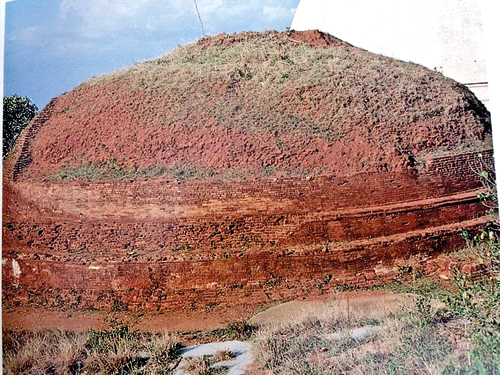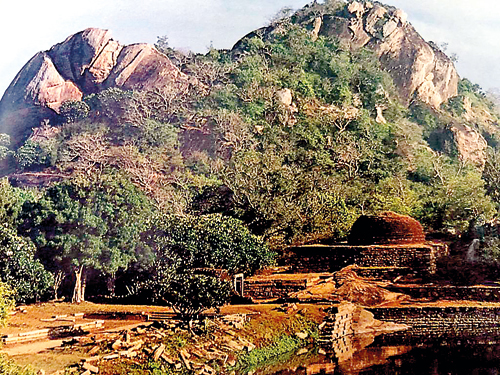The hidden treasures of a sacred rock

Eth Vehera. Pix by Wimal Perera from Prof. J. B. Disanayaka’s book ‘Mihintale’
The pilgrim’s progress in Mihintale follows a time-worn path; you walk up the grand stairway of smooth steps- 1840 of them- feeding the macaques and the giant squirrels- indolent, fussy connoisseurs of mango; you walk around the crowded Ambastala stupa; dutifully climb the rock where King Tissa met Sage Mahinda; stand with a shiver before the eerie Naga pond with its five hooded cobra. Throw in perhaps a visit to the Maha Stupa – and the Poson ritual is considered done.
The real Mihintale, meanwhile, remains hidden and unknown. To encounter it is to follow the rugged path of the ascetic monk, as he searches out the wild windswept lonely crags and isolated looming forest caves. For, while Mihintale was a rich and grand monastery for the better part of history, it is in the isolated spots that its true spirit remains- touched by monks in search of Nirvana.
Here in innumerable caves they dwelt – away from the hustle and bustle of the royal city, even in that dark period after the 12th Century when the monastery with all its sophistication – fell mysteriously and suddenly into decay.
If you happen to be at the sacred mountain on a quiet day, visit these little known sanctuaries a stroll away from the beaten track. For the searcher, the poet, the archaeologist and the historian, the old mountain still offers a rare portal of escape.

Mihindu Seya
Mihindu Seya
‘Cetiya Pabbata’ was the old name for Mihintale- the ‘mountain of stupas’. It was peppered with them- and many of them still stand unnoticed. Amongst the oldest is Mihindu Seya. An endearingly small, uneven mound, it was identified by Dr. Senarat Paranavitana as the monument built over the remains of Arahat Mahinda, who died at the age of 80.
Prof. J. B. Disanayaka, who in fact was part of digs at Anuradhapura as a youth- says in his book ‘Mihintale’ that the stupa was built by King Uttiya, successor of King Devanampiya Tissa.
When the archaeologists entered the relic chamber, a surprise awaited: despite signs of treasure hunters being there already, the royal offerings nestled intact in a polished black casket of earthenware: with two exquisite stupa-shaped reliquaries of thin gold foil- and within them fragments of bone and ashes. These date back roughly to the time of Mahinda’s death- late 3rd Century BC.
There were also Buddha statues of gilt bronze and gold foil- these from the much later Polonnaruwa era.
Eth Vehera
Clinging to the highest windswept peak in the area is a hardy tortoise-shell shaped stupa. Prof. Disanayaka says that Eth Vehera- meaning Elephant stupa- was part of a separate monastery- not to do with Mihintale itself- though the Mahavamsa remains silent about a monastery with that name.
The long climb of 600 steps is rewarded with a stunning panorama, especially at dusk- and on clear days the chequered spread below goes as far as Anuradhapura with the misty silhouettes of Ruwanweliseya and other monuments.

Rajagiri Kanda
Rajagiri Kanda
This jungle-clad mountain harbours a series of caves. It lies within 400 metres from the Kaludiya Pokuna car park. Here, in the heyday of Mihintale, lived the most virtuous and wise of monks- among them Dharma-Gupta whose paean is immortalized in the Fifth Century travelogue of the Chinese monk Fa Hsien. There is deep serenity here amidst the bleached remnants of a monastery.
Giribandha Cetiya
Another small turtle-backed stupa, the Giribandha has the distinction of having retained a relic chamber whose murals stun with their pristine glory. It shows remnants of 28 figures- prodigious for frescoes from the Anuradhapura period- which are tantalizingly rare with sketchy samples.
Says Paranavitana of the frescoes: “They depict divine beings among clouds which have cut off the lower parts of their bodies. The figures have been sketched in outline only, red and black being the pigments used, but are of highest artistic quality, indicating that the artist possessed skill in draughtsmanship, a subtle sense of form and an understanding of the principles of balanced composition.”
Mihintale Museum
The archaeological museum is located between the grand staircase and the Mihintale junction. It houses a reconstruction of the relic chamber of Giribandha Cetiya- and bronze figurines of Hindu deities, ancient tools, ceramics and ola leaf manuscripts.
Thimbiri Pokuna
Linger a bit in the dark shade by this, the second largest pond in Mihintale. Herds of deer skitter around for drinks while birds are aplenty most of the time.
Wasammale
The legend of Pandukhabaya has no equal in the island- a demi-supernatural king who seems to have rallied close around his sceptre the native Yaksas and the new Aryan conquerors. Just two kilometres north of Mihintale town, in the jungle, is a rock called Wasammale, resplendent with luminescent Kandyan murals and two ponds- which never dry out. One of them, with a long underwater tunnel, is said to be where young Pandukhabaya hid when his royal uncles murdered every boy his age in the village. Dwaramandala, the cowherd village that adopted him- reminiscent of Krisna legends- is said to be nearby.
| Remember with gratitude this great day: Ven. Dhammaratana Thera | |
| Mihintale is the cradle of Sinhala Buddhist civilization, for this is where Arahat Mahinda, son of great Indian emperor Asoka, arrived in the 3rd Century BC with the message of Buddhism. The mountain then became a monastery- a very well organized, sophisticated one by around the Eighth Century. The site today stands as testimony to former monastic grandeur and great spiritual heights. Talking of this Poson Poya, the full moon of June, Chief Incumbent of Mihintale Raja Maha Vihara, Ven Dr. Walawahengunuwewa Dhammaratana Thera reflected that while this year which marks the 2328th anniversary of the advent of Sage Mahinda, we cannot celebrate as before, we can display the Buddhist flag at home and temple- and remember, with gratitude- the Thera Mahinda. “We as a people have always valued gratitude- and we are all indebted for the gift Arahat Mahinda brought us. When he died at 80, the then monarch, King Uttiya, called that day Sri Mihindu Pura Atavaka- so the first quarter moon of October still bears his name. “What he instilled in us still remains in our blood and bones. Coincidentally, this year, the poya fell on World Environment Day. Buddhism is a religion deeply connected to nature. But more importantly, Mahinda, like the Buddha, was a great nature lover and Mihintale is thought to be the first wildlife sanctuary in the world.” Mihintale would have the aloka pooja- and sil programme- but there would be no gatherings of people this year, the Ven. Dhammaratana added. |



